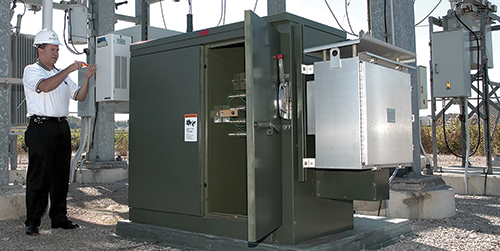We are speaking with Lily Ho, Vice President of Product Management for Aclara.
EET&D : We hear a lot about RF networks for advanced metering infrastructure (AMI). Is Power Line Communication a viable option for utilities?
Ho : Yes, Power Line Communication (PLC) is actually the best solution for many AMI requirements and is often preferred to RF, depending on certain conditions. PLC meets all the essential AMI system requirements and with advancements made in concurrent feeder/phase communication it now delivers exceptional improvements in network throughput.
For example, PLC systems are ideal for utilities operating high geographically disbursed networks (e.g. a low density of end points per square mile) because the required investment in communication infrastructure is very low. PLC only requires communication equipment in the substation to collect and convey information from end points. There is no additional network infrastructure needed as all communications goes over the existing power lines. Anywhere that an electric signal goes, we can get out to the meter or device even if it’s more than 100 miles away. Plus, investment in R&D on technologies and add-on solutions that use PLC data to deliver an ever-broadening array of new capabilities continues.
EET&D : What are the benefits and advantages of PLC?
Ho : The benefits and advantages of PLC really relate to the fact that the infrastructure it needs to operate exists by virtue of the electric distribution network. This differs from an RF network, which is dependent on data collectors placed within range of the meters at all points. The only infrastructure equipment that’s required with PLC is substation communications equipment. Different from Power Line Carrier solutions, no intermediary equipment such as repeaters, line conditioners, or any kind of signal booster are needed.
This is an important consideration for utilities with meters that are dispersed over a large geographic region. With RF-based AMI, a network infrastructure must be built to read meters and devices, and while this type of system works well in densely populated areas, it can be inefficient for those utilities that are more rural. For example, if a utility has a meter density of 20 meters per square mile, a DCU and access-point infrastructure is still required to be able to read those meters, which may be cost inefficient.
EET&D : What are the differences between power-line communications and power-line carrier?
Ho : The real difference between the two is that PLC does not generate a carrier signal over the distribution line as Power Line Carrier solutions do. Instead, PLC modulates at the zero cross of the sine wave. On the outbound signal, PLC modulates at the zero cross on voltage, and on the inbound signal it modulates on current.
This enables an exceptionally robust communication network even in the face of line harmonics and other distortions that degrade Power Line Carrier network performance. These issues do not affect PLC network performance.
EET&D : How are PLC solutions poised to meet the throughput and performance demands of AMI?
Ho : In addition to supporting all current AMI system requirements, PLC is also uniquely positioned to meet future demands not only from the standpoint of performance, but also in relation to reinforcing other technologies that Aclara brings to the market.
There are instances where power line may be the primary infrastructure technology chosen, but where RF or cellular network technology could be used to meet specific requirements for throughput, data rate, or number of channels over the air. For example, a utility may have its residential meters on a PLC system, but may have some commercial meters transmitting data at five-minute intervals to support time of use rates. In this type of case a cellular or RF solution might supplement the PLC system. Combining technologies and offering a hybrid solution benefits utilities by allowing them to leverage data collected from all sources.
For example, Aclara has developed unique fault detection and localization solution that employs one-byte fast ping signals to collect data in areas where there might be a power outage. Then enhanced data analytics are applied to identify areas of probability for an outage, to verify where power failures have occurred, and to monitor restoration.
PLC also has ability to deploy analytics in the head end, which allows us to leverage the information that would normally be collected.
In terms of throughput, PLC can collect data in up to 15-minute intervals and perform on-demand reads. Moreover, in addition to being able to perform concurrent communications on feeder and phase, sophisticated grouping methodology in the head end system allows grouping reads together on an outbound basis, allowing the system to handle groups containing up to 256 devices. That enables PLC to deliver the throughput and performance that customers require.
Plus, when you look at the installed base, no customers have exceeded a 50% free time network usage. What this means is that for many customers, a daily read or the customer’s daily requirements are finished within three to four hours. Since no one has saturated a network more than 50%, there’s still a lot of capacity and capability to take advantage of in the PLC systems out there.
There also continue to be developments to improve the ability of PLC to read meters and perform other functions, allowing it to work even faster. As customers have articulated requirements, there are certainly situations where a five-minute interval would be beneficial. These requirements can be met with other solutions in a hybrid situation. The key is to sit down and talk with customers to understand what they need and how to align PLC to meet their performance requirements.
EET&D : What other functional areas beyond AMI can PLC support?
Ho : From a functional perspective, PLC systems support load control and demand response solutions, as well as capacitor switch bank controllers and transponders. In fact, demand response systems were some of the earliest solutions available over power lines, even for customers not using AMI.
EET&D : Is PLC always a suitable technology solution?
Ho : There are some power distribution architectures—such as those that are typically found in higher density urban environments—that don’t really lend themselves to using PLC. For instance, where a high number of feeders are emerging downstream from a distribution substation. If those feeders are interconnected, then issues could result related to feedback of the power line signal, causing distortion.

A power line communication system operates on existing power line
infrastructure, with communications equipment required in the substation.
EET&D : What about the use of power-line communications in urban environments? Is there a way to mix power-line communications with RF?
Ho : When we talk with some customers that have a mix of urban and geographically disbursed environments, that’s where we start to discuss hybrid systems that combine RF and PLC.
For dealing with urban-rural cases, the key is to understand meter densities. The meter-dense area could be a city, but it could also be a growing subdivision with a much higher density than the bulk of a service territory. Obviously, the challenge in a hybrid system is not to double up on the infrastructure. The utility must separate the substations that have the more geographically disbursed assets from those that have a higher meter density, and apply the most appropriate solution to each group of substations.
By blending PLC and RF, hybrid solutions could offer significantly lower cost of ownership for the customer. This requires an examination of the structure in terms of substations, including what areas are more urban. By closely working with the customer, the data about substation configurations necessary for applying the best combination of solutions can be developed.
EET&D : What is the advantage of investing in the technology and what do you see as the future for power-line communications solutions?
Ho : We’re investing not only in the actual communication technology, but also in the analytics – what we do with the data. Combined with the knowledge we’ve gained through our acquisition of a meters company, our data scientists have been very creative in how we leverage the data from our smart meters to create new value. For instance, the prospect of developing a cost-effective PMU (phasor measurement unit), is something that would have proved challenging in the past, but is now something that we are considering.
And it’s not necessarily just infrastructure that we’re investing in—it’s the entire solution for the customer. Certainly, we have next generation R&D in the works where we are looking at ways to reduce the cost of substation communication equipment. We also will also be integrating some of our grid monitoring solutions with PLC so that we can provide enhanced fault detection with smart grid sensors on the medium-voltage side of the distribution grid. In addition, much of our development is happening at the head end and system as we try to take advantage of the data we’re collecting to provide a broader range of solutions.
Because of its unique capabilities, PLC is specifically suited to a segment of the North American power distribution market where it is the ideal, best-in-class solution.
About the Author
 Lily Ho leads Electric AMI product management and new product introduction initiatives at Aclara. As Vice President of Product Management and Product Marketing/ Electric, she is responsible for driving growth in Aclara’s smart infrastructure solutions portfolio. Ho has over 15 years of experience in the energy and utility space managing large engineering projects closely aligned with risk management and sales functions. Before joining Aclara, Ho worked at TransCanada and, most recently, GE Energy, where she was responsible for over $400 million of sales in the Power Generation Services business.
Lily Ho leads Electric AMI product management and new product introduction initiatives at Aclara. As Vice President of Product Management and Product Marketing/ Electric, she is responsible for driving growth in Aclara’s smart infrastructure solutions portfolio. Ho has over 15 years of experience in the energy and utility space managing large engineering projects closely aligned with risk management and sales functions. Before joining Aclara, Ho worked at TransCanada and, most recently, GE Energy, where she was responsible for over $400 million of sales in the Power Generation Services business.
Ho holds a Bachelor of Aerospace Engineering degree from Carleton University.







